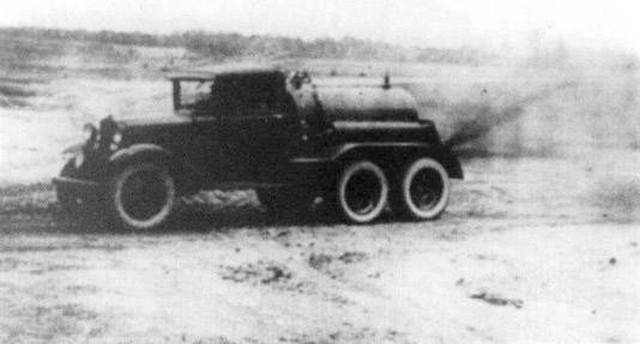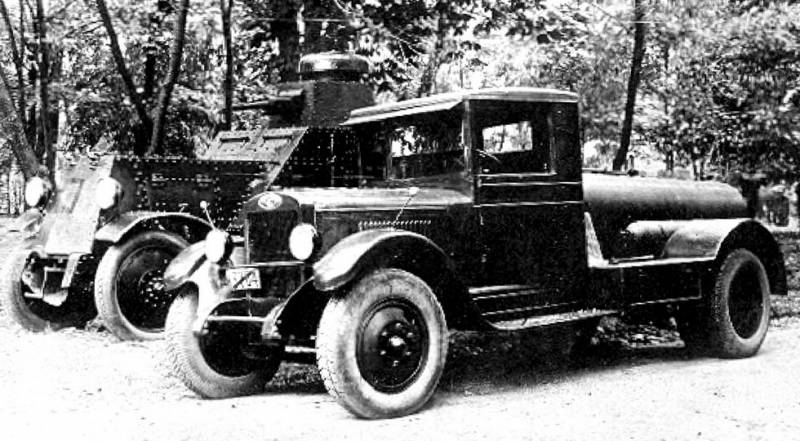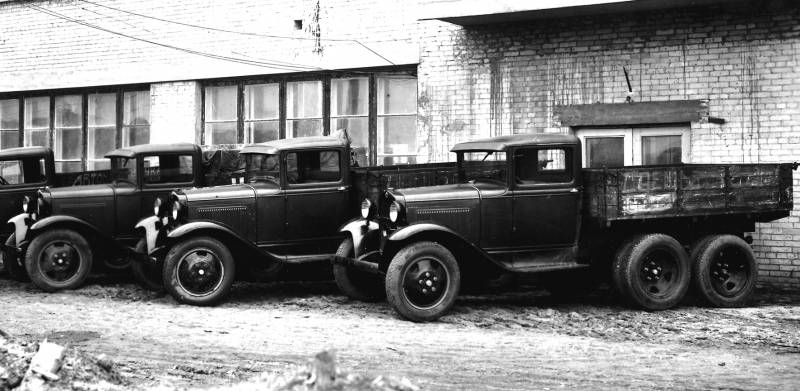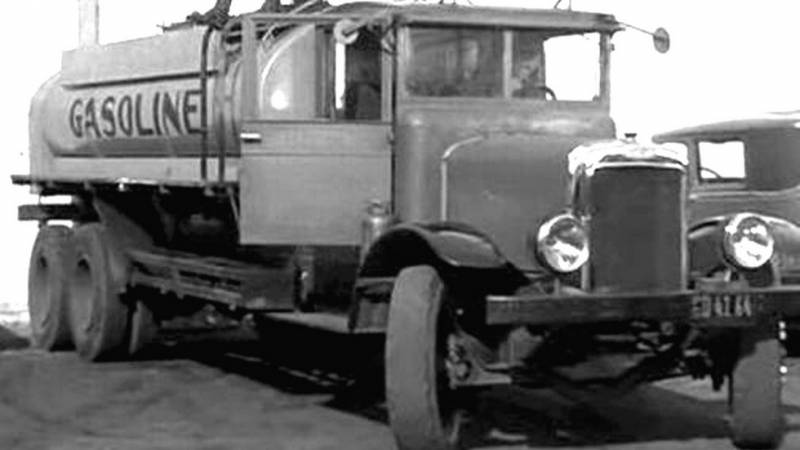Projects of chemical armored cars on serial automobile chassis
 The experimental machine BHM-800 is processing the terrain. Photo aviarmor.net
The experimental machine BHM-800 is processing the terrain. Photo aviarmor.netAt the end of 1930, the Experimental Design and Testing Bureau of the Directorate of Mechanization and Motorization of the Red Army (OKIB UMM), headed by Nikolai Ivanovich Dyrenkov, began work on the topic of chemical armored vehicles. Subsequently, the Kompressor plant was attracted to this direction. The result of this work was the emergence of several curious prototypes - but none of these projects went into series.
On an affordable chassis
In the early thirties, our country struggled with a shortage of vehicles and other equipment, which is why the UMM of the Red Army worked out the issue of using affordable vehicles as the basis for armored vehicles of various classes. So, the first Soviet chemical tank developed by OKIB was built on the basis of the Kommunar tractor. Similarly, it was planned to make new armored cars.
For the new chemical armored vehicles, OKIB immediately chose two existing automobile chassis with a 6x4 wheel arrangement. These were Ford-Timken and Moreland TX6 cars. Their characteristics corresponded to the design loads, and in addition, they were available in sufficient quantities and could be used in new projects. By that time, Ford-Timken and Moreland had managed to master some military specialties, and now they were to become the base for chemical armored cars.
OKIB projects
In the middle of 1931 OKIB UMM began the development of two armored cars on different chassis. A sample called D-6 was based on the TX18 machine. A similar development at Ford-Timken was named D-39. The projects included the removal of all "extra" regular parts, instead of which new devices of one kind or another were mounted.
Armored cars were supposed to have bulletproof protection made of rolled sheets with a thickness of 6 to 8 mm. The engine casing and cabin were assembled from armored panels. An armored casing for target equipment was placed on the cargo platform of the chassis. Thus, the D-18 and D-39 armored cars could work at the forefront, giving the crew and cargo protection from bullets.
During the construction of the D-18 and D-39, the power set, propulsion system, transmission and undercarriage of the base chassis did not change, so that the main characteristics remained at the same level. However, most of the reserve capacity was spent on the armored hull and chemical equipment, which affected the mass of the liquid load.
On the D-18 armored car, the cargo area with armor was given over to two tanks with a total capacity of 1100 liters. Only one 39-l tank was installed on the D-800. The pumping equipment of the KS-18 type manufactured by the Kompressor plant was responsible for spraying chemicals. It consisted of a stern horseshoe sprayer for spraying CWA and a spray column for degassing or setting smoke screens. The operation of the spray devices was provided by a centrifugal pump driven by an engine.
Depending on the task, D-18 and D-39 could take on board various liquids. The CWA sprayer ensured the contamination of a strip up to 25 m wide; the speed of movement in this case should not exceed 3-5 km / h. The spray column treated a strip 8 m wide during degassing.
The combat characteristics of armored cars directly depended on the capacity of the tanks. So, D-18 with a large supply of chemicals could create an infection zone 450-500 m long or carry out degassing of a section 350-400 m long. The smoke-generating mixture S-IV was enough to set up curtains for half an hour. The D-39 armored car had a smaller tank and the corresponding characteristics.
The prototypes D-18 and D-39 did not have any weapons for self-defense. Perhaps in the future they could get a DT machine gun on a particular installation.
The crew consisted of only two people. The driver was responsible for driving the machine, and the commander had to control the operation of the chemical equipment. In the presence of a machine gun, the commander could also become a shooter.
The development of the D-18 and D-39 machines began in mid-1931, but soon ran into organizational problems. The prototype D-18 was built only in the fall of the next 1932. A little later, the assembly of the D-39 was completed. To save money, both armored cars were built without the use of armor. Their hulls were made of structural steel to obtain the calculated mass.
December 1, 1932 OKIB UMM was disbanded. Two projects of chemical armored vehicles were transferred to the design bureau of the Kompressor plant. He participated in their development as a supplier of key components, and therefore had to cope with further work. Also in the future, this enterprise could create new projects.
At the turn of 1932-33. ground tests of two armored cars took place. The machines demonstrated satisfactory performance and coped with the tasks of spraying a conditional CWA or degassing the area. At the same time, Ford-Timken and Moreland TX6 car chassis performed poorly on rough terrain. In addition, the characteristic architecture and insufficiently strong armor limited combat survivability.
In its current form, the D-18 and D-39 were not of interest to the army, but could become the basis for new developments. The design bureau of the Kompressor plant took into account the experience of testing two samples from OKIB UMM and drew conclusions, after which it created its own machines of the same class.
Armored cars "Compressor"
In the first months of 1933, the Compressor began developing its own chemical armored car. This sample remained stories under the names BHM-1000 and BHM-1. The letters in the index meant "armored chemical vehicle", and the numbers indicated the capacity of the CWA tanks or the project number. From the point of view of general ideas, the BHM-1000 project repeated the developments of OKIB. The differences were in the list of units used.
The Compressor design bureau considered it inappropriate to use a foreign chassis. The basis for the BHM-1000 was the domestic truck AMO-3. Such a chassis in terms of carrying capacity was not inferior to imported ones, but it was decided to leave it without armor. Perhaps it could be added after testing and determining the approximate characteristics.
In place of the regular body of AMO-3, a metal tank with a capacity of 1000 liters was placed. A KS-18 complex with a pump and spray devices was also installed there. The use of such a system made it possible to maintain performance at the level of previous machines. Also, the capabilities and functions on the battlefield have not changed.
Armament was not installed on the prototype. For its installation, it was necessary to modify the standard cab of the base truck, and such a step could be considered unnecessary at the current stage of work.
In the same 1933, the chemical machine BHM-1000 without armor and weapons passed the test. The characteristics of the chemical equipment were confirmed and generally met the requirements. However, again there were problems with the chassis. The AMO-3 truck, even without armor, did not always cope with the load. The car hardly moved off-road, and the installation of protection would completely ruin its mobility.
The BHM-1000 product with such qualities was of no interest to the Red Army. However, the production of a small batch of such machines was ordered for use as training. This order was completed in the shortest possible time, and soon the chemical units were able to work out combat work on a completely new specialized equipment.
 Automatic filling station ARS-3 based on AMO-3 is a later model of chemical engineering. Photo Alternathistory.com
Automatic filling station ARS-3 based on AMO-3 is a later model of chemical engineering. Photo Alternathistory.comShortly after the BHM-1000, a prototype appeared called the BHM-800. It was built on the Ford-Timken chassis, using the same solutions as in the previous project. A tank with a capacity of 800 liters and a KS-18 system were installed on a serial truck. It was assumed that the BHM-800 would be similar in performance to the BHM-1000 - with the exception of parameters related to the payload.
The BHM-800 unarmored vehicle was tested and showed approximately the same results as the BHM-1000 and D-39. The target equipment again confirmed its characteristics, and the chassis again showed the impossibility of normal off-road operation. The future of another project was in doubt.
After completion of field tests in its original form, BHM-1000 and BHM-800 were slightly modified. As an experiment, they were equipped with protection in the form of structural steel cases. As in the OKIB projects, armor plates 6-8 mm thick were used. The installation of the hulls led to an increase in mass and a decrease in mobility. In this form, two "armored chemical vehicles" had no future.
New solutions
The projects of OKIB UMM and the Kompressor plant made it possible to test a number of not very successful ideas, as well as to find solutions suitable for further development. As for the prototype vehicles, all four prototypes appear to have been converted into trucks for their intended use.
Designers from the bureau of the Kompressor plant confirmed in practice that the KS-18 system is capable of solving the tasks set, however, a new base vehicle is needed for its successful application. The search for new chassis began, and in addition, the development of a special armored hull corresponding to the assigned tasks began.
The result of all these works was the appearance of a chemical armored car KS-18. It was not without flaws, but still met the requirements of the customer and was even built in a limited series. In addition, the so-called. filling stations - machines for degassing the area on an unprotected chassis. Thus, the D-18, D-39, BHM-1000 and BHM-800 projects nevertheless led to the desired results, albeit indirectly.


Information